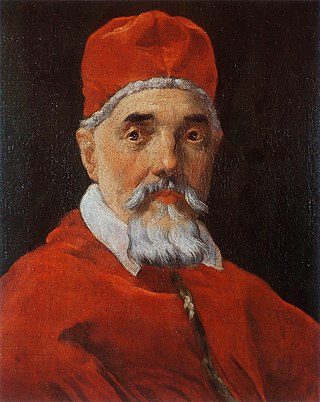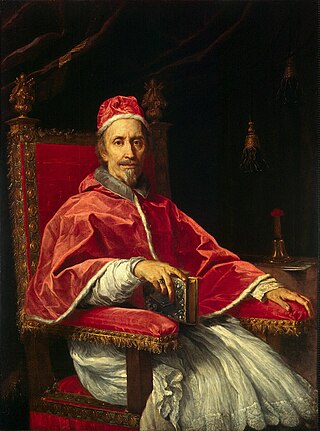
Pope Gregory XV, born Alessandro Ludovisi, was head of the Catholic Church and ruler of the Papal States from 9 February 1621 to his death in July 1623.

Pope Urban VIII, born Maffeo Vincenzo Barberini, was head of the Catholic Church and ruler of the Papal States from 6 August 1623 to his death, in July 1644. As pope, he expanded the papal territory by force of arms and advantageous politicking, and was also a prominent patron of the arts and a reformer of Church missions.

Pope Innocent X, born Giovanni Battista Pamphilj, was head of the Catholic Church and ruler of the Papal States from 15 September 1644 to his death, in January 1655.

A papal conclave is a gathering of the College of Cardinals convened to elect a bishop of Rome, also known as the pope. Catholics consider the pope to be the apostolic successor of Saint Peter and the earthly head of the Catholic Church.
A conclavist was a personal aide of a cardinal present in a papal conclave. The term is sometimes used to refer to all present with a conclave, including the cardinal-electors, but is more properly applied only to the non-cardinals. Conclavists played an important historical role in the negotiations of papal elections and in the evolution of secrecy, writing many of the extant accounts of papal elections.

Antonio Barberini was an Italian Catholic cardinal, Archbishop of Reims, military leader, patron of the arts and a prominent member of the House of Barberini. As one of the cardinal-nephews of Pope Urban VIII and a supporter of France, he played a significant role at a number of the papal conclaves of the 17th century. With his brothers Cardinal Francesco Barberini and Taddeo Barberini he helped to shape politics, religion, art and music of 17th century Italy. He is sometimes referred to as Antonio the Younger or Antonio Barberini iuniore to distinguish him from his uncle Antonio Marcello Barberini.

Ippolito Aldobrandini was a Catholic Cardinal. Pope Clement VIII, whose birth name was also Ippolito Aldobrandini, was his great-uncle.

A cardinal-nephew was a cardinal elevated by a pope who was that cardinal's relative. The practice of creating cardinal-nephews originated in the Middle Ages, and reached its apex during the 16th and 17th centuries. The last cardinal-nephew was named in 1689 and the practice was abolished in 1692. The word nepotism originally referred specifically to this practice, when it appeared in the English language about 1669. From the middle of the Avignon Papacy (1309–1377) until Pope Innocent XII's anti-nepotism bull, Romanum decet pontificem (1692), a pope without a cardinal-nephew was the exception to the rule. Every Renaissance pope who created cardinals appointed a relative to the College of Cardinals, and the nephew was the most common choice, although one of Alexander VI's creations was his own son.

A crown-cardinal was a cardinal protector of a Roman Catholic nation, nominated or funded by a Catholic monarch to serve as their representative within the College of Cardinals and, on occasion, to exercise the right claimed by some monarchs to veto a candidate for election to the papacy. More generally, the term may refer to any cardinal significant as a secular statesman or elevated at the request of a monarch.

The 1667 papal conclave was convened on the death of Pope Alexander VII and ended with the election of Cardinal Giulio Rospigliosi as Pope Clement IX. The conclave was dominated by factions loyal to the cardinal nephews of Alexander VII and Urban VIII. It saw the continued existence of the Squadrone Volante, or Flying Squadron, that had emerged in the 1655 conclave. The conclave also saw Spain and France, the two largest Catholic powers at the time, both support Rospigliosi's election as pope. Ultimately, Rospigliosi's election was achieved when the French ambassador bribed Flavio Chigi, Alexander's nephew, to support Rospigliosi. Following the conclave all the parties believed they had elected the pope that they had wanted.

In the papal conclave held from 8 to 9 February 1621, Cardinal Alessandro Ludovisi was elected to succeed Paul V as pope. Ludovisi took the name Gregory XV. It was the shortest conclave in the seventeenth century.

The 1669–70 papal conclave was convened on the death of Pope Clement IX and ended with the election of Cardinal Emilio Altieri as Pope Clement X. The election saw deference within the College of Cardinals to Louis XIV of France, and a freeing of the cardinals loyal to Spain to vote according to their conscience. Eventually the elderly Altieri was elected with support of the major factions within the College.

The 1644 papal conclave was called upon the death of Pope Urban VIII. It lasted from 9 August to 15 September 1644; the cardinal electors chose Cardinal Giovanni Battista Pamphili, who took office as Pope Innocent X.

The 1655 papal conclave was convened following the death of Pope Innocent X and ended with the election of Cardinal Fabio Chigi as Alexander VII. The conclave quickly reached a deadlock, with Giulio Cesare Sacchetti receiving 33 votes throughout the conclave, but never securing enough for his own election. After several months of deliberation and negotiation, Chigi was elected Pope when Cardinal Mazarin, the leader of the French government, consented to Chigi's election at the request of Sacchetti.

The 1689 papal conclave was convened after the death of Pope Innocent XI. It led to the election of Cardinal Pietro Vito Ottoboni as Pope Alexander VIII. The conclave saw previous factions join together because they lacked numerical strength, and saw the rise of the zelanti as a political force in the election of the next pope. Ottoboni was eventually unanimously elected with the consent of the secular monarchs, becoming the first Venetian in over 200 years to be elected pope.
Luigi Capponi was an Italian Catholic cardinal who became archbishop of Ravenna.

The March–April 1605 papal conclave was convened on the death of Pope Clement VIII and ended with the election of Cardinal Alessandro Ottaviano de' Medici as Pope Leo XI. It was the first of two papal conclaves in 1605; Leo died on 27 April 1605, twenty-six days after he was elected. The conclave was dominated by conflict over whether Cesare Baronius should be elected pope, and Philip III of Spain excluded both Baronius and the eventually successful candidate, Medici.

In the papal conclave held from 8 to 16 May 1605 Cardinal Camillo Borghes was elected to succeed Leo XI as pope. Borghes took the name Paul V. This was the second conclave of 1605, with the one that had elected Leo XI having concluded just 37 days earlier. It is significant for having the only recorded case of an injury at a papal conclave, which was the result of a physical fight amongst the cardinals over who should be elected pope.
Aeterni Patris Filius, also called Aeterni Patris, was a bull issued by Pope Gregory XV on 15 November 1621 that regulated papal conclaves. Together with the bull Decet Romanum pontificem of 1622, it formed the canonical basis for papal elections until the 20th century. The bull brought about many reforms to the papal election system, created structured rules, and sought to decrease the influence of organized factions within the College of Cardinals during the conclave as well as decrease the influence of secular monarchs on papal elections. It established general rules for the conclave process, while the later bull Decet Romanum pontificem addressed the ceremonial aspects of papal elections.

Pietro Campori was an Italian cardinal of the Catholic Church and Bishop of Cremona. He was friends with Scipione Borghese, the nephew of Pope Paul V, and was twice a candidate for election to the papacy, in the conclaves of 1621 and 1623.


















